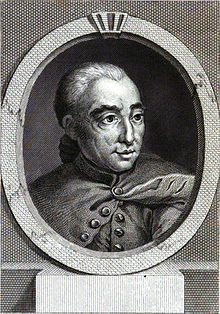RÉTIF DE LA BRETONNE
Nicolas-Edme Rétif (Restif; 1734-1806), better known as Rétif de la Bretonne, was a French writer. He was born at Sacy and educated at a Jansenist college. He worked in Paris as a journeyman printer and from the second half of the 1760s began a literary career. He was a prolific and versatile writer: h is oeuvre covers around two hundred volumes on all kinds of subjects, ranging from social-documentary novels to pornography. Many of his books were printed by himself. He sympathized with the Revolution, but he fell in disgrace because of his doubtful reputation and his aristocratic connections. His most well-known works were his monumental autobiography, Monsieur Nicolas (16 vols., 1794-1797), Les contemporaines (42 vols., 1780-1785, a collection of short stories), Anti-Justine (1793, a pornographic novel in response to De Sade’s Justine), and Les nuits de Paris (8 vols., 1786-1792).
The fragments:
The influence of the Thousand and one nights on 18th century literature is usually sought in forms of orientalism and exoticism, such as the Oriental tale or fantastic literature. However, the depth of the influence of the Nights can be assessed properly only by taken account of works which were inspired by its technique, structure, narrative strategy and concept as well. An example of such a work is Rétif de la Bretonne’s documentary novel Les nuits de Paris (1786-1792), a vast panorama of life in Paris at the eve of the Revolution. Like many of his works, the Nuits has an autobiographical touch. In his autobiography Monsieur Nicolas (1794-1797) Rétif has his protagonist/ alter ego reflect on the Thousand and one nights and its influence on ‘his’ works, saying that he has attempted to surpass the Nights in imagination and variety, and that he planned to write a series of works whose titles reflect the Arabic tales (Les mille et une metamorphoses, Les mille et une faveurs, etc.). This aim is realized in the work Les nuits de Paris, in which the framing story states that the author has wandered through the streets of Paris during 1001 Nights. This is the only explicit reference to the Nights which is further referred to through narrative strategies and motifs. The novel is divided into nights and contains various embedded stories; the stories are told to a certain Marquise, who thus acts as a kind of Shahriyar listening to Shahrazad/ Rétif; the night is presented as an exotic opposite of the day, full of marvellous and strange phenomena and experiences; like the Thousand and one nights, the work is all-encompassing, developing in a meandering way following the digressions and wanderings of the narrator; of course, the figure of the ‘nocturnal spectator’ reflects the Thousand and one nights character Harun al-Rashid, who wanders through Baghdad at night to inspect the condition of his subjects. In all these elements, the novel exemplifies the ways in which the model of the Nights was used to develop new literary forms and experiment with literary strategies, using the elements of self-reflexivity, self-generating stories, and the relationship between reality and the imagination. The work reflects the influence of Rousseau’s Les reveries d’un promeneur solitaire, Mariveau’s Lettres sur les habitants de Paris, and Louis Sébastien Mercier’s Tableau de Paris. It prefigures the feuilleton Les mystères de Paris by Eugène Sue, which also combines the figure of the nocturnal spectator with social critique. The fragment contains the introductory part and the first contemplations.

Sources/references:
Philippe Barr, Rétif de la Bretonne spectateur nocturne: une esthétique de la pauvreté, Rodopi. Amsterdam/ New York etc. 2012.
Charles Porter, Restif’s novels: or, an autobiography in search of an author, Yale University Press, New Haven/ London 1967.
Pierre Testud, Rétif de la Bretonne et la creation littéraire, Droz, Paris 1977.
Peter Wagstaff, Memory and desire: Rétif de la Bretonne, autobiography and utopia, Rodopi, Amsterdam/ New York 1996.